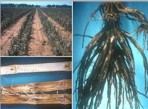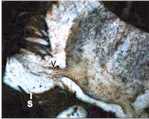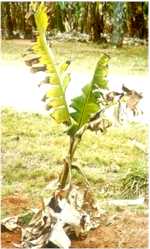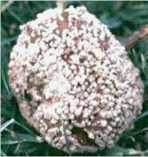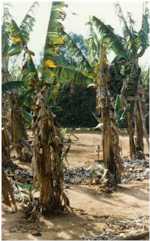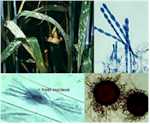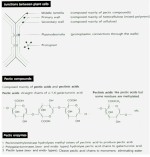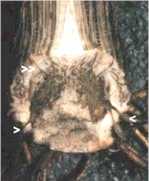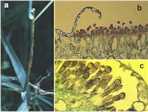..
CHAPTER 14: FUNGI AS PLANT PATHOGENS Chapter 14 covers the following major topics:
SAMPLE TEXT: Fungi are pre-eminent as plant pathogens. Roughly 70% of all the major crop diseases are caused by fungi, or the fungus-like Oomycota. One of the most notorious examples is potato late blight caused by Phytophthora infestans (Oomycota), which devastated potato crops in Ireland in the 1840s, leading to widespread famine. It is estimated that mire than half a million people died of starvation in that period, and a similar number emigrated to the rest of Europe and North America. Potato blight is still a potentially serious disease wherever potatoes are grown, despite many attempts to control it by plant breeding and fungicides (Chapter 17). A more recent example is the Great Bengal Famine of 1943, which is estimated to have cost the lives of some 2 million people, due to failure of the rice crops caused by a leaf-spot pathogen, Helminthosporium oryzae (now variously known as Bipolaris oryzae or Cochliobolus miyabeanus). Fungi also cause many serious diseases of landscape and amenity trees. Dutch elm disease, caused by Ophiostoma ulmi and the related species O. novo-ulmi, swept repeatedly across North America, Britain and continental Europeover the last century, decimating the elm populations. Similarly, chestnut blight, caused by Cryphonectria parasitica, has devastated the native American chestnut tree, Castanea dentata. This disease swept across much of the eastern part of the USA, after it was first recorded in the New York Zoological Garden in 1904. The magnificent American chestnut forests have now virtually disappeared and are represented only by a shrub-like understorey layer. Cinnamomi root rot, caused by Phytophthora cinnamomi, is another example of an introduced pathogen, currently threatening large tracts of natural eucalypt forest in Australia. And, at the time of writing, sudden oak death caused by Phytophthora ramorum is ravaging the natural oak woodlands in the coastal fog belt of northern California and southern Oregon. This ‘new disease’, first recorded in 1996, has now spread to many parts of Europe and is causing serious alarm. It has the potential to destroy many of Britain’s ancient woodlands. These are just a few examples of many that could be cited. Taken together, the epidemics in crop plants, plantations and natural woodlands have caused inestimable damage. In this chapter we focus on the activities of plant-pathogenic fungi and their several adaptations for causing disease. In chapter 17 we consider how these diseases can be controlled.
|
||||||||||||||||||||||||


